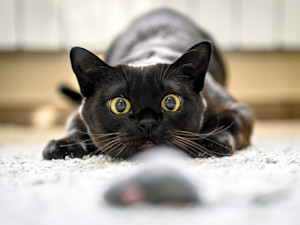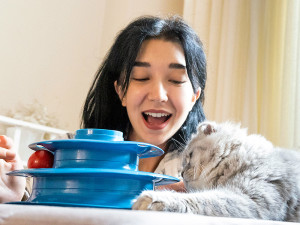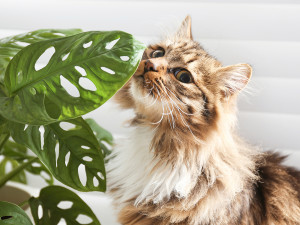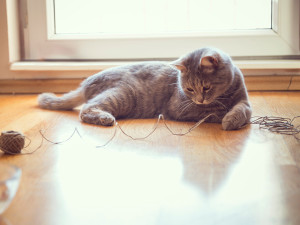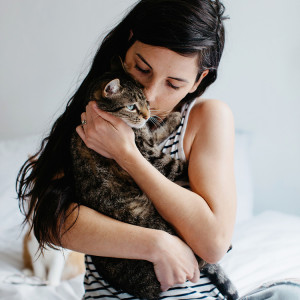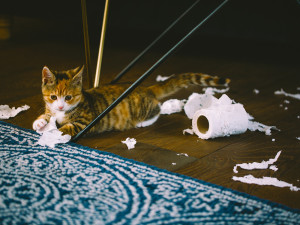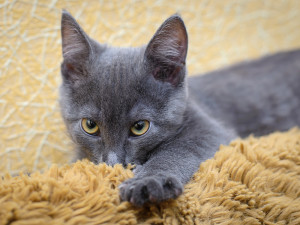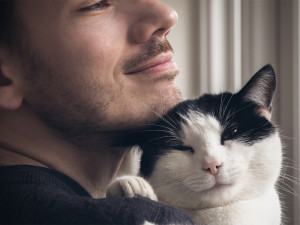The Surprising Reason Your Cat Can’t Get Enough Of Boxes (And Other Household Objects)
We discover the reasons your cat enjoys so many strange things

share article
Most cat parents can agree that our feline friends have their fair share of quirks, from drinking out of our water glasses to lifting their pawsopens in a new tab, knocking things off tablesopens in a new tab and zoomingopens in a new tab up the walls in the early hours. My cat, Cosmo, has a particular fascination with playing with nail files, among many other seemingly innocuous household items. And while many of us just accept truths like ‘cats love boxes’, have you ever wondered what the reasons are behind their obsessions? We spoke to the experts to find out.
Boxes
If you’ve ever found yourself feeling guilty for throwing away an empty cardboard box because your cat has been sitting in it for the last three days, you’ll be aware that cats are obsessed with boxes. Type ‘cats and boxes’ in TikTok and you’ll find yourself scrolling through hundreds of hilarious videos of kitties squeezing themselves into boxes, both big and small. After all, ‘If I fits, I sits’.
But why do our feline friends love a good box? According to the experts, there are a few reasons behind it.
The first comes from the way cats act in the wild: when they’re stalking preyopens in a new tab, they tend to hide so they can jump out at them. Cat behaviour consultant Stephen Quandt explains that cats are ambush predators. “So having a place to observe the world and watch for prey is useful to them.” At the same time, cats in the wild need to protect themselves and have likely evolved to hide in small spaces.
From a comfort perspective, cats tend to like smaller, cosier spaces, too. Vet Dr Kathryn Dench estimates that “approximately 90 percent of domestic cats show a preference for enclosed spaces, aligning with their natural instincts to seek out secure, sheltered areas to rest”. Small spaces keep cats warm and let them relax, secure in the knowledge that they’re safe.
Nail files
Whenever I start to do my nails, Cosmo comes running. His favourite toys are emery boards and nail buffers, so much so that he always tries to steal mine. He’s got tons of them lying around the house and loves to play with them.
Given the opportunity, Cosmo will sniff and rub his face on a nail file. If I throw one for him, he’ll start to play and throw it up in the air. But why does he like them so much?
According to Stephen, cats are attracted to nail files because they smell like us. “Your cat likes your smell,” so he or she is drawn to objects that smell like you. “A nail file also has a rough texture and may remind your cat of another cat’s rough tongue, which is used in grooming,” says Stephen.
A word of caution: Stephen also mentions that filing our nails leaves traces of keratin and calciumopens in a new tab. If your cat is obsessed with your nail kit, they might be experiencing a nutritional deficiency and trying to get these from your file. A keratin deficiencyopens in a new tab might look like red, flaky skin, loss of hair colour and hair breakage. This may be seen as crusty skin lesions with patchy spots and dry, brittle hair coats – so if you notice any of these signs along with your cat’s obsession with nail fails, then you should speak to your vet.
You should also make sure that your cat isn’t ingesting any part of the nail file – if they start tearing it up rather than just batting it around, take it away and keep them safely tucked away in drawers in future.
Receipts and pieces of paper
Ever noticed your cat will swerve their lovely fluffy bed and the soft, warm, carpet to sit on a bit of paper or to play with it? Some experts suspect this is down to cats’ love of small square spaces (see boxes) but translated into a 2D version. But there are some other reasons behind it, too.
“There’s a lot of sensory stimulation in a humble piece of paper,” says cat behaviour expert Susan Nilson. Rustling paper can indicate prey to cats as it mimics the sound of leaves moving when small animals run. The texture can feel interesting on their paws and in their mouths. Playing with paper gives cats “an all-important outlet for their innate hunting behaviours,” says Susan.
When it comes to sitting on paper, Stephen explains that it could help cats feel warmer because paper is an insulator and reflects their body heat back to them.
Artificial plants (but not real ones)
Cosmo is curious about the plants outside, but he loves the fake ones indoors. The experts suggest this is because fake flowers offer a similar sort of sensory stimulation (they can bat the leaves with their paws and hear the rustle) as real ones, without the potential to cause harm. Lots of plants contain toxinsopens in a new tab that make them, at best, taste terrible to cats and at worst, cause life-threatening sickness – whereas artificial plants don’t have these deterrents.
Dr Dench also hypothesises that artificial and dried plants can be more tempting because of their robust shapes. “The shapes are intriguing to cats,” she explains. “And, they can withstand the rough play that might damage more delicate, real plants.”
Anything made from wool – socks, gloves, your favourite jumper
Alongside his collection of nail files, Cosmo also owns two pairs of gloves and a few socks. My theory is that gloves and socks move in a satisfying way, almost recreating the natural movement of a small animal that would serve as Cosmo’s prey in the wild. Dr Dench agrees: “Wool mimics the texture of potential prey such as small mammals, making it an attractive material for cats to knead and paw at.”
There could be a comfort factor at play, too. Susan explains that “wool sucking is relatively common in cats, especially the Oriental breeds.” It could be a behaviour learnt as a kitten or it could be because the texture of wool reminds our feline friends of their mother.
You should always make sure to supervise your cat when they’re playing with wool, as ingestion of strands can cause an intestinal blockageopens in a new tab, which can be very serious. When a cat swallows string, one end of the string can get anchored early in the digestive tract, usually under the tongue. The free end of the string continues to try to move through the intestines. Because the string is anchored, the normal movement of the GI tract will cause the intestines to bunch up around the string instead of pushing it through. This bunching is called plication and is one of the hallmarks of a linear obstruction.
The most common symptoms in cats with GI obstruction are vomitingopens in a new tab, loss of appetiteopens in a new tab, and lethargy. These symptoms can be seen with both major and minor problems, so any vomiting or appetite change warrants a visit to your veterinarian. Do not. Under any circumstances. Pull a string from your cat’s bum. Ever. If you’re seeing one end of a string, that means the other end could be anchored somewhere else in your cat’s GI tract (maybe as far up as the tongue). Pulling the string can put tension and friction on the intestines, possibly worsening plication and cutting a hole into the intestinal wall. As tempting as it can seem, don’t do it. Just get your cat to the vet.
However odd our cat’s behaviour may seem, there’s usually some kind of psychological or evolutionary reason behind it, proving our feline friends are just as mysterious as ever.

Charlotte Nash
Charlotte is a writer with a grumpy cat named Cosmo. She (Charlotte, not Cosmo) has worked with brands including BorrowMyDoggy, Oddbox and Octopus, and is based in the UK by the sea. Charlotte works as a freelance writer to keep Cosmo in the life he’s become accustomed to.
Related articles
![dark-haired woman hugging cat that has imprinted on her]() opens in a new tab
opens in a new tab10 Signs Your Cat Has Imprinted On You
Feeling like you have a little shadow these days? A cat behaviourist explains why that’s happening
![A calico tabby kitten chewing and tearing a roll of toilet tissue.]() opens in a new tab
opens in a new tabWhy Does My Cat Chew On Everything?
How to decode your cat’s chewing habits when they’re nibbling on all the things
![grey kitten kneading blanket]() opens in a new tab
opens in a new tabWhy Is My Cat So Kneady?
A cat behaviourist says ‘making biscuits’ could mean your cat thinks you’re their mum...
![cat snuggling man]() opens in a new tab
opens in a new tabWhat’s Your Cat’s Love Language?
Five surprising ways cats show affection (and how you can show it back), according to a cat behaviourist
![Kitten scratching fabric sofa]() opens in a new tab
opens in a new tabHow to Stop Your Cat From Absolutely Ripping Apart Your Couch
Placing a cat tree or post in a room only, uh, scratches the surface of solving this problem
